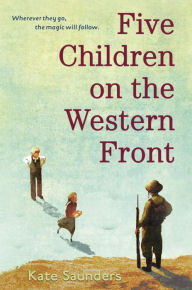Edith Nesbit’s classic characters go ten years into their future in this thought-provoking sequel.
Five Children on the Western Front, by Kate Saunders. Delacorte, 2016, 247 pages.
Reading Level: Middle Grades, ages 10-12
Recommended for: ages 8-14
Fans of Edith Nesbit like her breezy style, her comfortable use of Edwardian slang, her humor, and her effortless evocation of what we would like to call a “simpler time.” The thirty-odd years around the turn of the twentieth century were, by all accounts, a more optimistic time: rapid strides in technology were making life easier, Europe had been at peace for decades, prosperity was on the march, and it was safe to be an agnostic. Nesbit was an agnostic, as well as a Fabian socialist, and her books were refreshingly free of Victorian piety. The Psammead series beginning with The Five Children and It (1902) introduced a 4000-year-old sand fairy with the power to grant wishes, but only for a day, and often with a too-literal interpretation of the wish.
The age of optimism came to a crashing and permanent end in 1914, where this spinoff novel begins. The original five children now number six, and are ten years older: Cyril, the oldest, is headed for the front where the Great War is raging. His baby brother, nicknamed Lamb, is now eleven and big brother to Edith, age 9. Lamb and Edith discover the Psammead (pronounced something like “Sammy-ad”) has returned and taken up residence in the gravel pit behind their home in Kent. But why? And why have his powers diminished? And why does he have bad dreams and less control over how and when he appears? An ancient justice is apparently at work and the “It” himself needs help to unravel his sins and figure out how he may atone for them. It’s interesting to track the theme of repentance outside a Christian context. Sin and guilt have been consistent throughout history, and simple justice requires “the universe” hold the Psammead accountable for his tyrannical ways in a distant millennia. Whether the penance is adequate would make a good discussion topic, but the resolution is surprisingly touching.
Carrying on another author’s characters and premise is a risky project. Children who are already familiar with these characters may find the story more enjoyable at first, but in the end it stands on its own.
Overall Rating: 4 (out of 5)
- Worldview/moral value: 3.75
- Artistic value: 4
Support our writers and help keep Redeemed Reader ad-free by joining the Redeemed Reader Fellowship.
Stay Up to Date!
Get the information you need to make wise choices about books for your children and teens.
Our weekly newsletter includes our latest reviews, related links from around the web, a featured book list, book trivia, and more. We never sell your information. You may unsubscribe at any time.
We'd love to hear from you!
Our comments are now limited to our members (both Silver and Golden Key). Members, you just need to log in with your normal log-in credentials!
Not a member yet? You can join the Silver Key ($2.99/month) for a free 2-week trial. Cancel at any time. Find out more about membership here.

